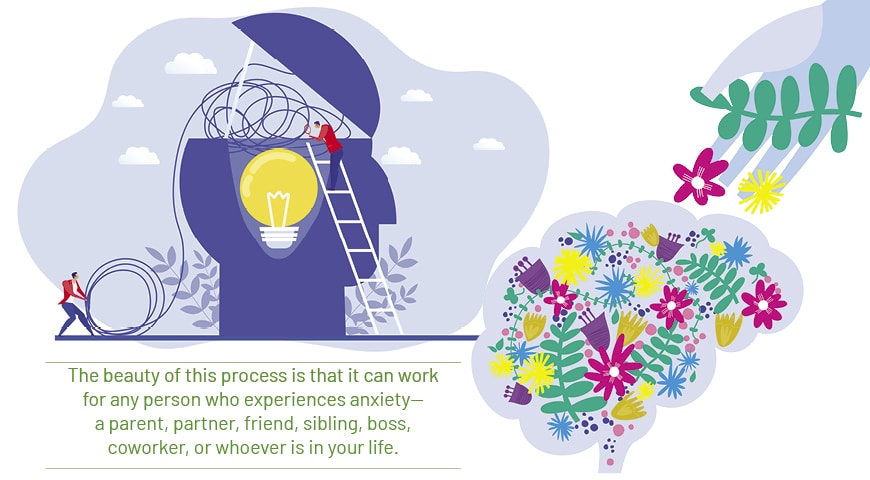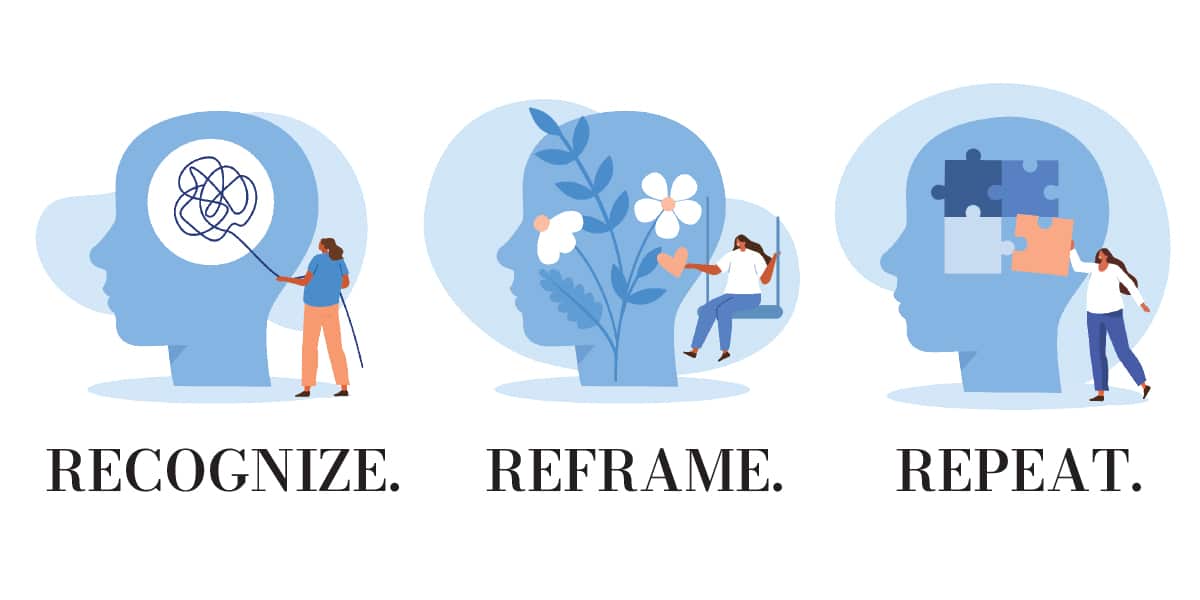A Franciscan therapist offers practical tips rooted in prayer to help ease our anxiety.
Between the Russo-Ukrainian War, the COVID-19 pandemic, and other personal issues in our lives, the past few years have been quite a challenge. Whether or not you have been diagnosed with an anxiety disorder, I am sure you can relate to feelings of anxiety.
Anxiety can present itself in many ways, such as increased worry, difficulty sleeping, finding yourself more exhausted, and maybe indulging in more food than usual. We’ve seen an increase in anxiety, especially in the past two years. I don’t know about you, but mine has gone up, even though I take medication for an anxiety disorder.
So, what can we do about it? How can we face these challenges in a way that can decrease our anxiety? I am going to offer you a way to do that. I call it the Three Rs: Recognize, Reframe, and Repeat. Note that this approach is not evidence-based or peer-reviewed. It comes from my own personal experience with an anxiety disorder and my clinical background.
Before we get into the Three Rs, I need to give you some context. Let’s start with me. I am a Capuchin Franciscan priest ministering in Detroit, Michigan, a licensed clinical social worker, and someone who suffers from generalized anxiety disorder (GAD). For the past 10 years, I have spent many days diving into my anxiety disorder and trying to find ways, beyond taking medication, to deal with my increased anxiousness.
GAD affects every element of your life. Whether it is work, home life, family life, community, or extracurricular activities, anxiety plays a role. Often it looks like replaying in your head conversations you have had or are yet to have. It also can come about when you have a project to finish. Your mind takes control, and you fear that you are not going to get it done in time or that it is not going to be good enough.
Having an anxiety disorder can also affect your mood and self-esteem. You can at times feel sad because you don’t think you handled something well, or you can feel overwhelmed because you have too many things on your plate. Sleep can be challenging because, when you lay your head down, all the worries and challenges of the day flood into your mind like a dam breaking open. This is all to say that I understand what life with anxiety is like. I live it every day.
I am a professional therapist, and with that comes a wealth of knowledge around a variety of social theories. The Three Rs are impacted by this knowledge. I won’t go into great detail, but I am drawing from both cognitive behavioral therapy (CBT) and mindfulness-based cognitive therapy (MBCT).
CBT focuses on how we process our thoughts and works to change behaviors that are impacted by our thoughts. For example, if you think, I am bad at tests, then you will probably do poorly on the next test you take. CBT can help change that.
MBCT uses mindfulness, a Buddhist practice that helps an individual focus on the present. Think of it this way: If you are feeling anxious, which may cause rapid breathing, you take some time to focus on your breath. This very action will help to reduce your rapid breathing and then your anxiety.
With this background information in place, let’s get to the more practical application of these theories. The Three Rs strategy consists of Recognize, Reframe, and Repeat. Let’s start with Recognize.
Recognize.
Being a Capuchin Franciscan has exposed me to the rich writings of Franciscans from the past 800 years. St. Clare of Assisi has had a strong impact on my spirituality, particularly because of her devotion to the Eucharist. In her early writings, she often talks about the concept of gazing. St. Clare shared with all she could the power of gazing into the real presence of Jesus in the Eucharist. In her last words, she was recorded saying: “Gaze upon him, consider him, contemplate him, as you desire to imitate him. . . . Totally love him, who gave himself totally for your love.” What a powerful way to reflect on the real presence of our Lord!
Can’t we take this same gaze and turn it to our thoughts? And even take it a step further, where we not only gaze but also acknowledge or, as I put it, Recognize. To recognize is to see fully with eyes and heart, to understand, to encounter, but most of all to accept. To recognize does not take in the polarity of good and evil; it simply is. When you are asked to recognize the thought, the anxiety that you are feeling, I am simply asking you to recognize the thought for what it is.
Let’s say I am preparing for a presentation. Every time I think about the presentation, I get anxious because I keep thinking that I am not a great public speaker. To recognize means that I accept the thought for what it is: I feel anxious because I don’t think I am a great public speaker. I do my best to remove any negative feelings I have about this thought and simply allow the thought to rest in my mind. I let all other thoughts out of my mind, welcome the thought to the table, and sit with it.
This is where our Christian faith comes in. Why don’t we take a moment and welcome Jesus to the table? For this situation, I would invite Jesus to help me to recognize the statement. Allow yourself to sit in the moment with the thought before you decide to take the next step.
Another example of Recognize could be that you just got a promotion at work, and your boss calls you into his or her office. And all you can think is, Oh no, what did I do wrong? Your anxiety builds. You allow the thought to come to the forefront instead of pushing it down. You begin the recognition stage by sitting with the phrase What did I do wrong? You remove any feelings that you have around it and simply sit with it.
You invite Jesus to the table, and you clear your mind of all the other thoughts. You simply “gaze” into it, letting it be. Draw all your attention to that phrase, look at each word closely, and let the words rest in your mind. Try to remove all judgment or rationale, and simply allow the statement to be just that—a statement with no extras attached to it. Then, when you are ready, enter the next phase, which is to Reframe.

Reframe.
Reframing is a common tool that is used by therapists, especially with CBT. Reframing is basically what it sounds like: You take the thought you have and try to change the perspective. It is like changing the frame of a picture to match others or make different elements stand out. Let’s go back to the earlier example. You say to yourself before the presentation, “I am not a great public speaker.” With Reframe, you change the statement to make it less anxiety-provoking or to avoid pointing out a particular flaw. You may change it to, “Lots of people struggle with public speaking.”
This phrase does a couple of things. First, it takes the focus completely off you and puts it on the community at large. Saying that others struggle with this allows you to see that you are not alone in your feelings. This can help to alleviate some anxiety. It also neutralizes the statement so that it doesn’t have a negative or positive emotion attached to it. You are basically stating a fact. Facts are neither good nor bad; they are simply neutral information. And in this case, the fact is true. Lots of people, even celebrities, struggle with public speaking. By reframing, you take the thought that intensifies your anxiety and make it into a phrase that will hopefully decrease your anxiety.
So, what about Jesus? Remember how you invited Jesus to sit with you at the table? What if you ask Jesus to help you reframe? Or reframe it from Jesus’ perspective. Remember “WWJD,” that catchphrase that was so popular in the late ’90s? Ask yourself: What would Jesus do? How would Jesus reframe this? What would he say? He might say: “Public speaking made me nervous too. Don’t worry. We got this.”
In my head, Jesus always adds a comforting message. You are probably asking yourself, Did Jesus really get nervous when he spoke publicly? We don’t know. Why not see if it helps you to manage your fear of public speaking? Remember these are practices that we do in our heads, and they usually don’t last very long. The more you practice, probably the faster you will get at it.
Let’s look at the other example, “What did I do wrong?” Take a few minutes and think about how you would reframe this. How would Jesus reframe the statement?
Repeat.
The last step is Repeat, which is honestly the most challenging because it requires you to re-encounter a potentially difficult space multiple times. Many people would prefer to just think of something and then move on. But for negative thoughts and trauma, it is going to take more than one time. This is especially the case for those thoughts that are deeply rooted in your mind.
Most of us remember the adage, “Practice makes perfect.” Practice does make perfect. The more you practice steps one and two (Recognize and Reframe), the better you become at using those techniques when you are faced with an anxiety-provoking situation. Think about when your doctor provides you with medical advice about a particular health problem. Do you think that doctors pull that information from their heads on the spot? They draw from their experience, medical knowledge, and their familiarity with your case. It’s the same with this process. The more we engage with these steps, the more comfortable we become using them. So, Repeat, Repeat, Repeat!

A Real-Life Example
Let’s walk through these steps with an example. The other day when I was at work, I said hello to one of my staff members. She gave me one of those fake smiles and kept walking. I immediately thought, Oh my gosh, that person is mad at me. I spent several minutes thinking over the past couple hours and days, reviewing our conversations to see if there was a sign to indicate that I made her upset.
Then I thought: Let’s use the Three Rs. Step one: Recognize. I sat with the phrase She must be mad at me because she didn’t say hi to me when I said hello. I sat with each word, and the ones that stuck out were “She, Mad, Me, Hello.” So, I thought to myself, How do I let this simply be instead of feeling like a horrible boss because I made an employee upset? I just let the statement be. “This person is mad at me.” Then I invited Jesus into the conversation, asking, “Jesus, do you see anything?” A thought surfaced: Are you sure she is mad at you? Jesus had a point. She could just be having a bad day, and it may have nothing to do with me. I could have just left it there, but I am pretty sure that would not help with my anxiety about the situation.
I moved to the next step, Reframe. How can I reframe this? Well, let’s look at what Jesus said, “Are you sure she is mad at you?” People carry all sorts of things in their minds, so it is possible that this person was just thinking about something else that made her upset. It may have nothing to do with me. A possible reframe here would be, “It seems that this person is upset about something.”
What I did here is remove the blame and simply state a fact. The person was upset. We saw this when she gave me a fake smile. So, I have taken out all of the negative feelings attached to the statement and simply made it a fact. By doing this, I am helping my anxiety about the situation to decrease. This way, when I see my employee later, I can simply say: “Hey, I noticed you were not very happy earlier. Everything OK? Can I help?”
Then I repeat and simply keep going through the process, maybe diving deeper each time, to help decrease any feelings of anxiety. The more I enter into this conversation, the more I will learn about myself. For instance, why did I think my employee’s reaction was about me? Or, does she often seem upset? This process gives us time to work through that thought that started it all: She is mad at me. Try this the next time you are feeling anxious. The process is rather simple—just Three Rs.
Recognize, Reframe, Repeat: three Rs to help you deal with your daily anxiety. The beauty of this process is that it can work for any person who experiences anxiety—a parent, partner, friend, sibling, boss, coworker, or anyone in your life.
You don’t need a psychologist or a social worker to do this, though it may help to bring this process to therapy to talk about how it went. Next time you feel anxious, or any strong emotion, simply look at the thought (Recognize) with Jesus, see how you can reexamine the statement to remove some of the strong emotion (Reframe), and then do it again the next time it comes up (Repeat).
And remember: Jesus is always with you. Just ask for help.








